Multi-Fidelity Surrogate Models for Predicting Averaged Heat Transfer Coefficients on Endwall of Turbine Blades
Abstract
:1. Introduction
2. Research Methods
2.1. Gaussian Process-Based Multi-Fidelity Surrogate
2.2. Design of Experiments for Low-Fidelity and High-Fidelity Samples
2.3. Experiment of High-Fidelity Sample
2.4. Simulation for Low-Fidelity Samples
3. Results and Discussion
3.1. Low-Fidelity and High-Fidelity Surrogate Modeling for Heat Transfer Coefficient
3.2. Evaluate the Accuracy of MFS
4. Conclusions
Author Contributions
Funding
Institutional Review Board Statement
Informed Consent Statement
Conflicts of Interest
Nomenclature
| BL | Boundary layer |
| Chord length of the blade | |
| & | Corresponding function of low and high-fidelity |
| DoE | Design of experiments |
| Discrepancy surrogate | |
| GP | Gaussian process |
| HT | Heat transfer |
| HTC | Heat transfer coefficient () |
| HF | High-fidelity |
| HF-GP | High-fidelity-based Gaussian process |
| XH | High-fidelity dataset |
| High-fidelity model | |
| Thermal conductivity (here, air is fluid) | |
| LF | Low-fidelity |
| LF-GP | Low-fidelity-based Gaussian process |
| XL | Low-fidelity dataset |
| Low-fidelity model | |
| & | Low and high-fidelity surrogate |
| MFS | Multi-fidelity surrogate |
| Nusselt number | |
| Regression scalar | |
| Reynolds number | |
| RMSE | Root-mean-square error |
| Sherwood number |
References
- Yu, K.; Yang, X.; Yue, Z. Aerodynamic and heat transfer design optimization of internally cooling turbine blade based different surrogate model. Struct. Multidisc. Optim. 2011, 44, 75–83. [Google Scholar] [CrossRef]
- Choi, W.S.; Song, G.W.; Chang, S.Y.; Kim, B.S. Life assessment of gas turbine blade based on actual operation condition. Trans. Korean Soc. Mech. Eng. A 2014, 38, 1185–1191. [Google Scholar] [CrossRef]
- Mazur, Z.; Luna-Ramirez, A.; Juárez-Islas, J.A.; Campos-Amezcua, A. Failure analysis of a gas turbine blade made of inconel 738LC alloy. Eng. Fail. Anal. 2005, 12, 474–486. [Google Scholar] [CrossRef]
- Carter, T.J. Common failures in gas turbine blades. Eng. Fail. Anal. 2005, 12, 237–247. [Google Scholar] [CrossRef]
- Choi, W.S.; Chang, S.Y.; Kim, B.S.; Chen, Y.; Liu, Y.; Zhao, J.; Banerjee, A. The TMF life assessment of first-stage W501F turbine blade under different operating temperatures. In Proceedings of the ASME Turbo Expo 2015: Turbine Technical Conference and Exposition, Montreal, QC, Canada, 15–19 June 2015. ASME paper GT2015-43479. [Google Scholar]
- Han, J.C. Fundamental gas turbine heat transfer. J. Therm. Sci. Eng. Appl. 2013, 5, 021007. [Google Scholar] [CrossRef]
- Reyhani, M.R.; Alizadeh, M.; Fathi, A.; Khaledi, H. Turbine blade temperature calculation and life estimation—A sensitivity analysis. Propuls. Power Res. 2013, 2, 148–161. [Google Scholar] [CrossRef] [Green Version]
- Park, J.S.; Choi, W.S. Heat and mass transfer characteristics on the first-stage gas turbine blade under unsteady wake flow. Int. J. Therm. Sci. 2019, 138, 314–321. [Google Scholar] [CrossRef]
- Kandasamy, M.; Peri, D.; Ooi, S.K.; Carrica, P.; Stern, F.; Campana, E.F.; Osborne, P.; Cote, J.; Macdonald, N.; de Waal, N. Multi-Fidelity Optimization of a High-Speed Foil-Assisted Semi-Planning Catamaran for Low Wake. J. Mar. Sci. Technol. 2011, 16, 143–156. [Google Scholar] [CrossRef]
- Perdikaris, P.; Raissi, M.; Damianou, A.; Lawrence, N.D.; Karniadakis, G.E. Nonlinear information fusion algorithms for data-efficient multi-fidelity modelling. Proc. R. Soc. Lond. A Math. Phys. Eng. Sci. 2017, 473, 20160751. [Google Scholar] [CrossRef]
- Zou, Z.; Liu, J.; Zhang, W.; Wang, P. Shroud leakage flow models and a multi-dimensional coupling CFD (computational fluid dynamics) method for shrouded turbines. Energy 2016, 103, 410–429. [Google Scholar] [CrossRef]
- Minisci, E.; Vasile, M. Robust design of a reentry unmanned space vehicle by multifidelity evolution control. AIAA J. 2013, 51, 1284–1295. [Google Scholar] [CrossRef] [Green Version]
- Jonsson, I.M.; Leifsson, L.; Koziel, S.; Tesfahunegn, Y.A.; Bekasiewicz, A. Shape optimization of trawl-doors using variable-fidelity models and space mapping. Procedia Comput. Sci. 2015, 51, 905–913. [Google Scholar] [CrossRef] [Green Version]
- Forrester, A.I.; Bressloff, N.W.; Keane, A.J. Optimization using surrogate models and partially converged computational fluid dynamics simulations. Proc. R. Soc. Lond. A Math. Phys. Eng. Sci. 2006, 462, 2177–2204. [Google Scholar] [CrossRef]
- Kennedy, M.C.; O’Hagan, A. Predicting the output from a complex computer code when fast approximations are available. Biometrika 2000, 87, 1–13. [Google Scholar] [CrossRef] [Green Version]
- Qian, P.Z.; Wu, C.J. Bayesian hierarchical modeling for integrating low-accuracy and high-accuracy experiments. Technometrics 2008, 50, 192–204. [Google Scholar] [CrossRef]
- Balabanov, V.; Grossman, B.; Watson, L.; Mason, W.; Haftka, R. Multifidelity response surface model for HSCT wing bending material weight. In Proceedings of the 7th AIAA/USAF/NASA/ISSMO Symposium on Multidisciplinary Analysis and Optimization, St. Louis, MO, USA, 2–4 September 1998; pp. 778–788, Paper No. AIAA-98-4804. [Google Scholar]
- Mason, B.H.; Haftka, R.T.; Johnson, E.R.; Farley, G.L. Variable complexity design of composite fuselage frames by response surface techniques. Thin. Wall. Struct. 1998, 32, 235–261. [Google Scholar] [CrossRef]
- Knill, D.L.; Giunta, A.A.; Baker, C.A.; Grossman, B.; Mason, W.H.; Haftka, R.T.; Watson, L.T. Response surface models combining linear and euler aerodynamics for supersonic transport design. J. Aircr. 1999, 36, 75–86. [Google Scholar] [CrossRef]
- Viana, F.A.C. Surrogates Toolbox User’s Guide, 3rd ed.; University of Florida: Gainesville, FL, USA, 2011. [Google Scholar]
- Le Gratiet, L. Multi-fidelity gaussian process regression for computer experiments. Ph.D. Thesis, Université Paris-Diderot-Paris VII, Paris, France, 2013. [Google Scholar]
- Fischer, C.C.; Grandhi, R.V. A surrogate-based adjustment factor approach to multi-fidelity design optimization. In Proceedings of the 17th AIAA Non-Deterministic Approaches Conference, Kissimmee, FL, USA, 5–9 January 2015. Paper No. AIAA 2015-1375. [Google Scholar]
- Park, C.; Haftka, R.T.; Kim, N.H. Remarks on multi-fidelity surrogates. Struct. Multidiscip. Optim. 2017, 55, 1029–1050. [Google Scholar] [CrossRef]
- Campbell, K. Exploring Bayesian Model Calibration: A Guide to Intuition; Los Alamos Technical Report LAUR-02-7175; Los Alamos National Laboratory: Los Alamos, NM, USA, 2002. [Google Scholar]
- Swiler, L.P.; Trucano, T.G. Calibration under Uncertainty. SAND2005-14981498, Sandia National Laboratories (SNL-NM), Albuquerque, NM 87185-0370 (United States). 2005. Available online: https://prod-ng.sandia.gov/techlib-noauth/access-control.cgi/2005/051498.pdf (accessed on 1 August 2019).
- Forrester, A.I.; Sóbester, A.; Keane, A.J. Multi-fidelity optimization via surrogate modelling. Proc. R. Soc. A 2007, 463, 3251–3269. [Google Scholar] [CrossRef]
- Matsumura, T.; Haftka, R.T.; Kim, N.H. Accurate predictions from noisy data: Replication versus exploration with applications to structural failure. Struct. Multidiscip. Optim. 2015, 51, 23–40. [Google Scholar] [CrossRef]
- Higdon, D.; Kennedy, M.; Cavendish, J.C.; Cafeo, J.A.; Ryne, R.D. Combining field data and computer simulations for calibration and prediction. SIAM J. Sci. Comput. 2004, 26, 448–466. [Google Scholar] [CrossRef] [Green Version]
- Zhang, Y.; Kim, N.H.; Park, C.; Haftka, R.T. Multi-fidelity surrogate based on single linear regression. AIAA J. 2018, 56, 4944–4952. [Google Scholar] [CrossRef]
- Choi, W.; Jung, K.J.; Park, J.S. Characteristics of heat transfer on a turbine blade endwall under various inlet flow conditions. Exp. Heat Transf. 2020, 1–17. [Google Scholar] [CrossRef]


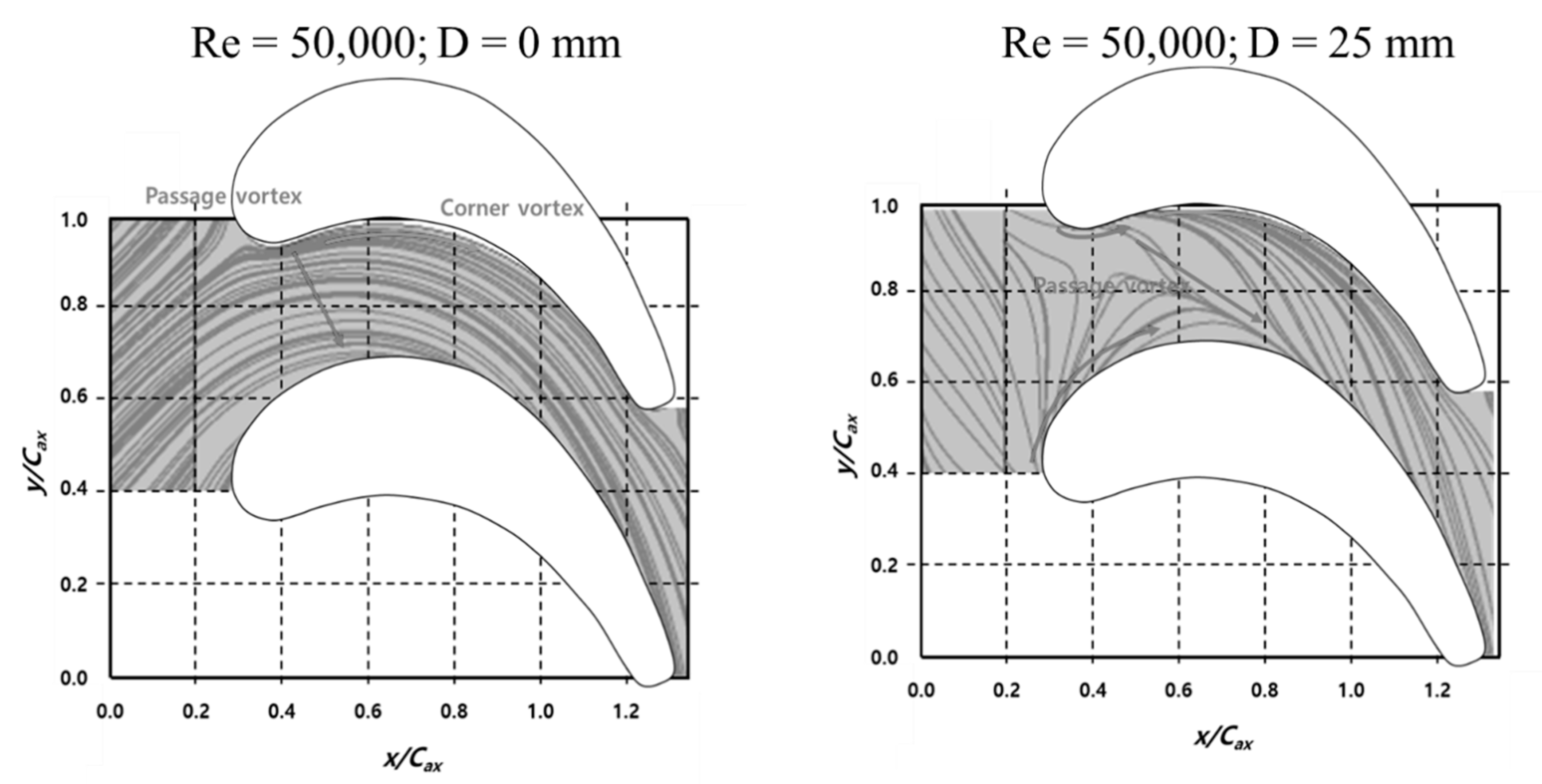
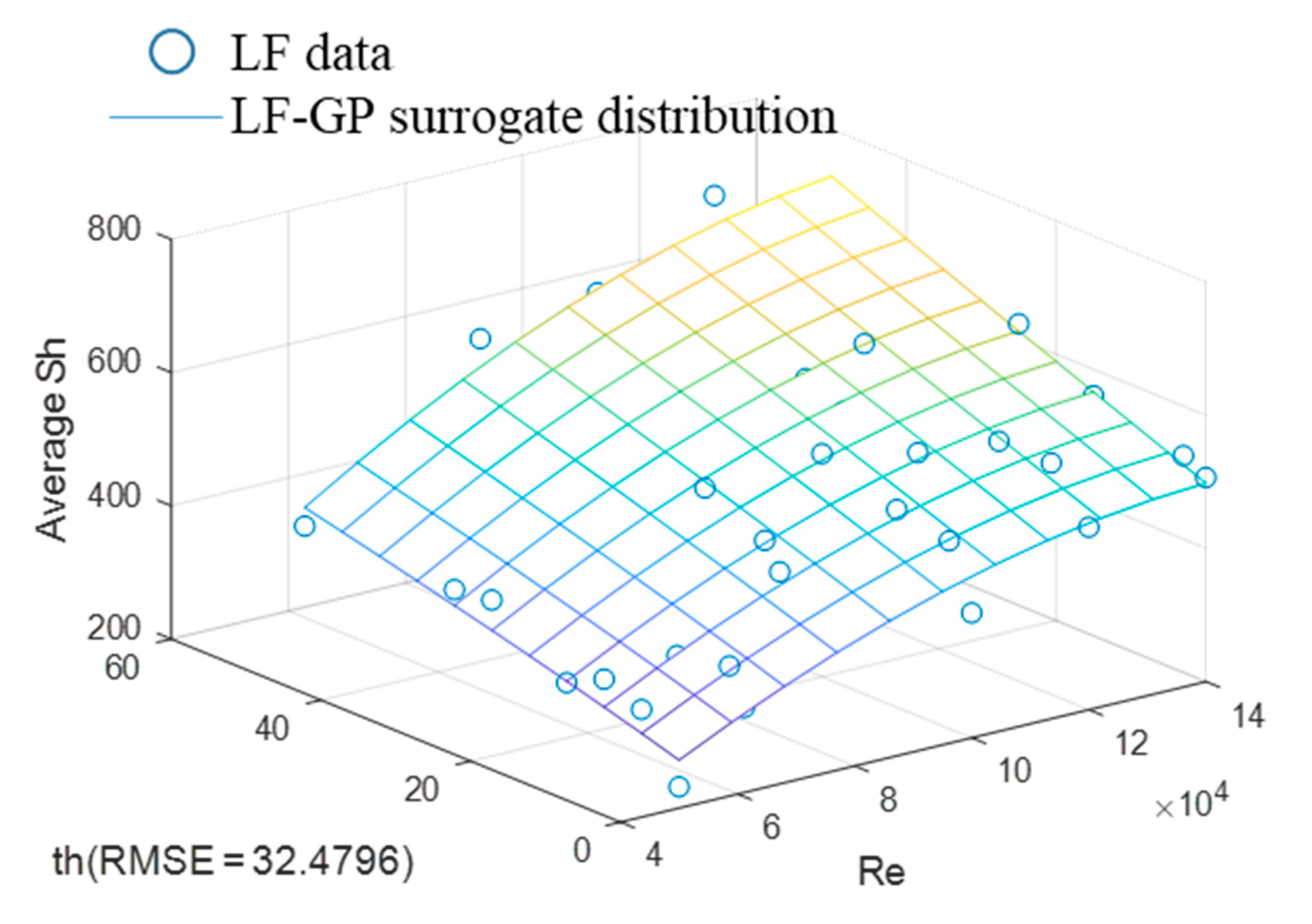
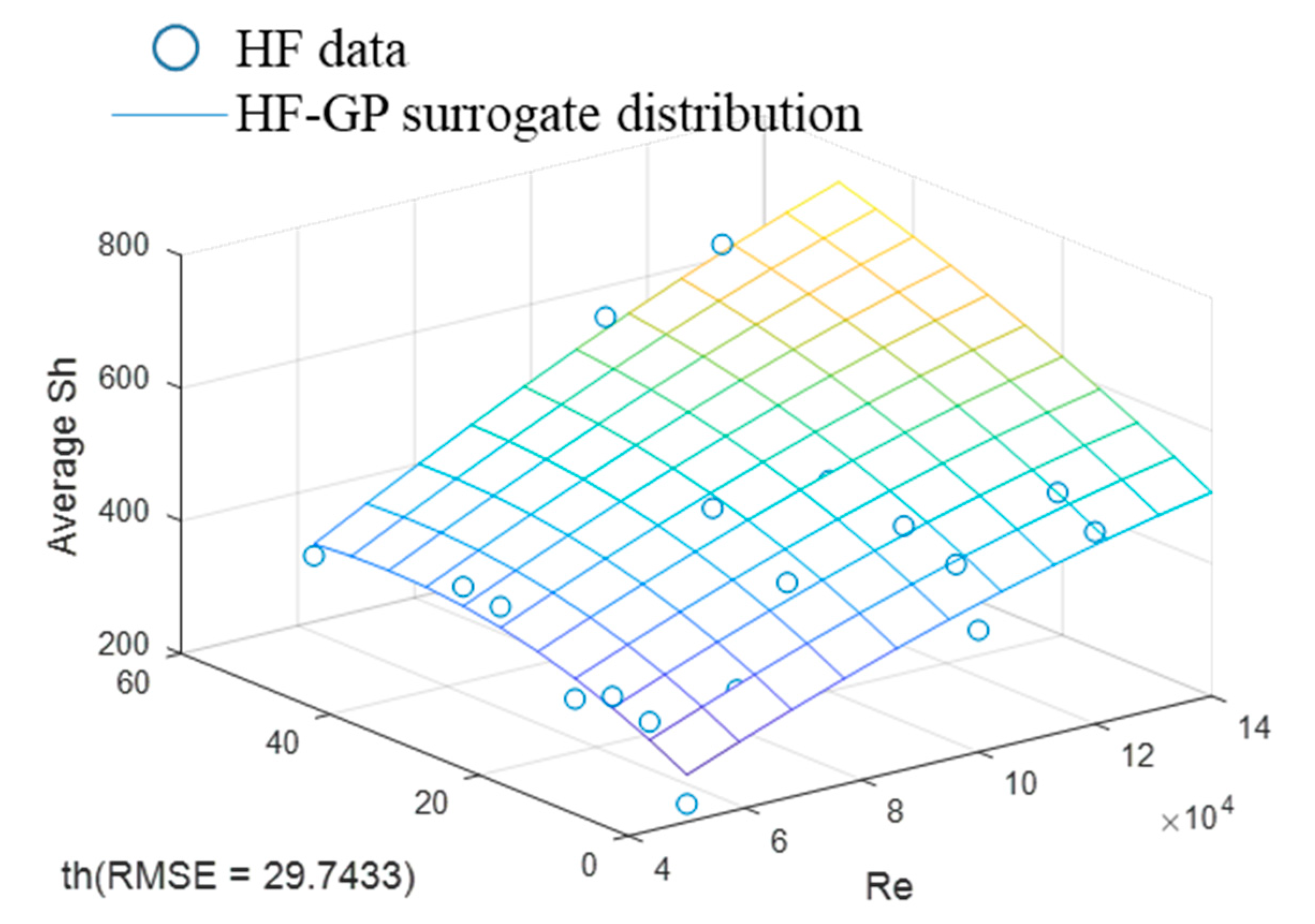

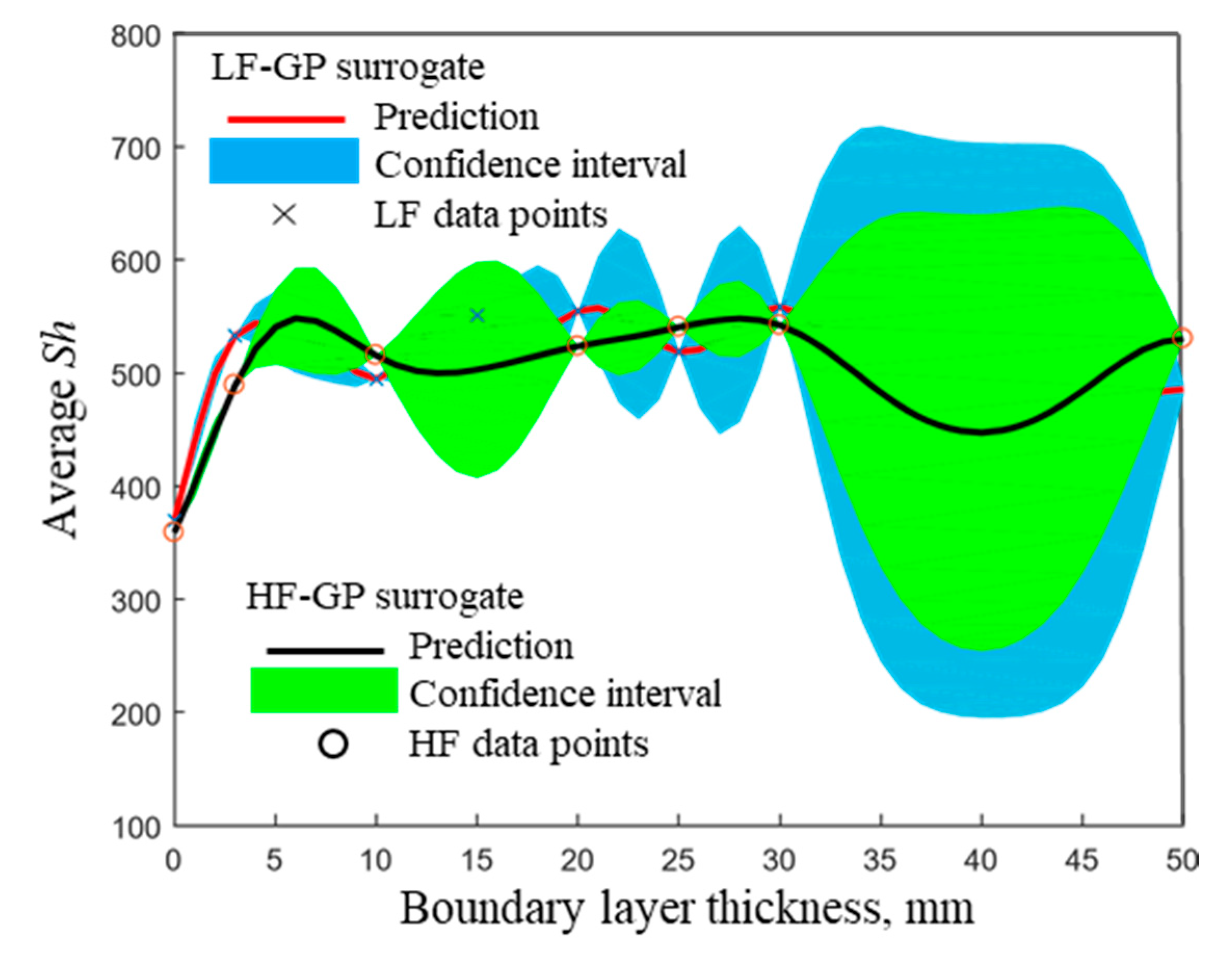

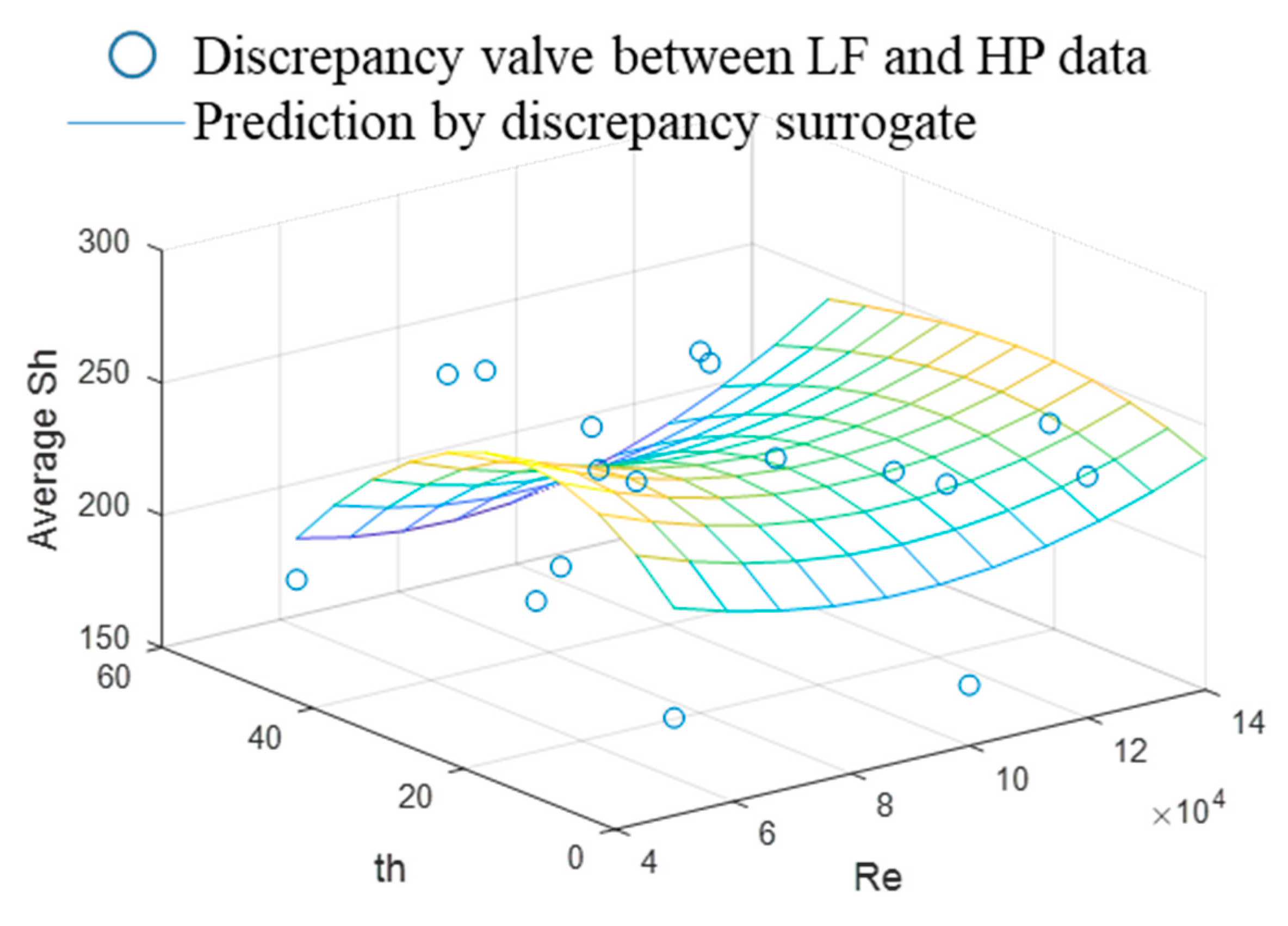
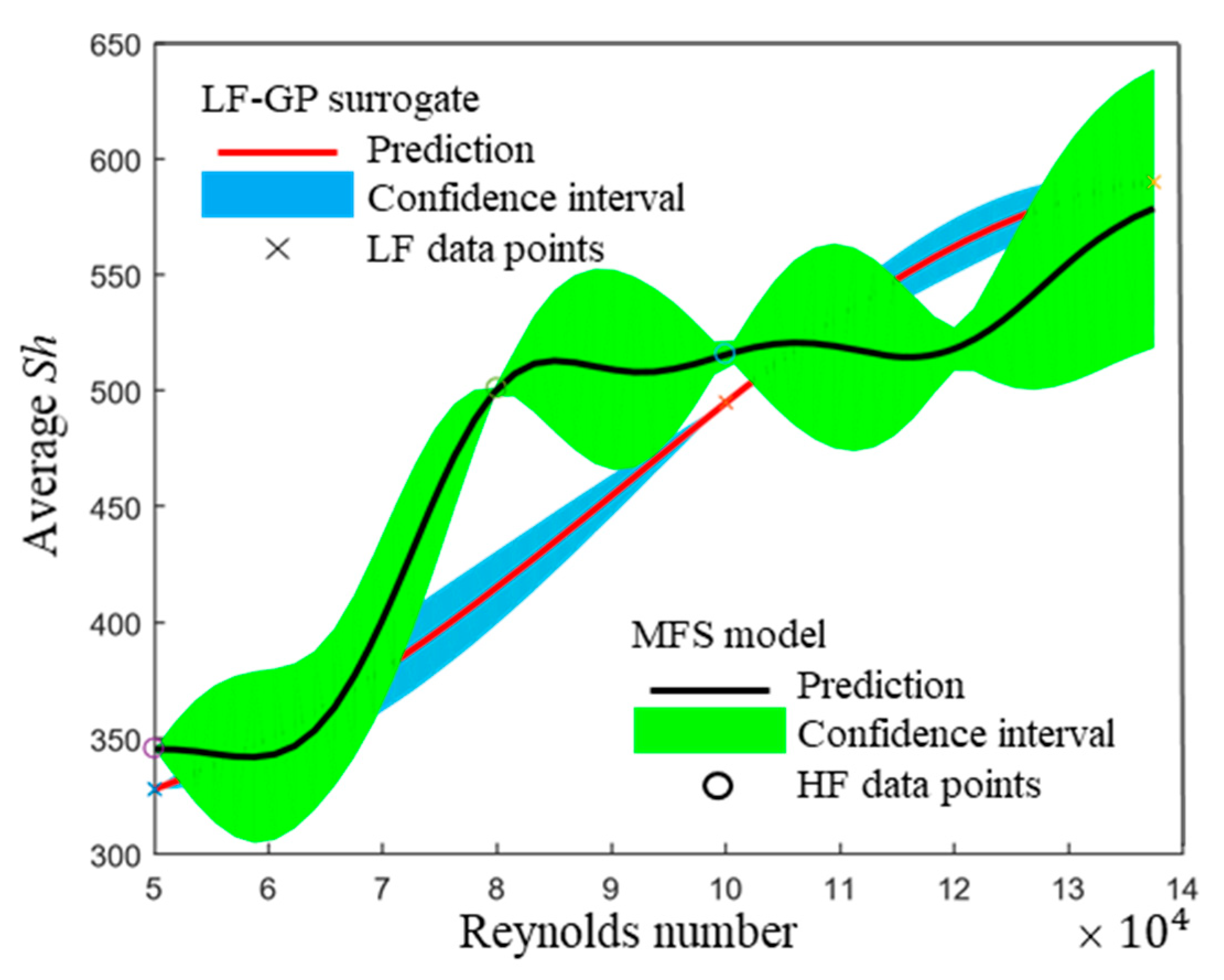
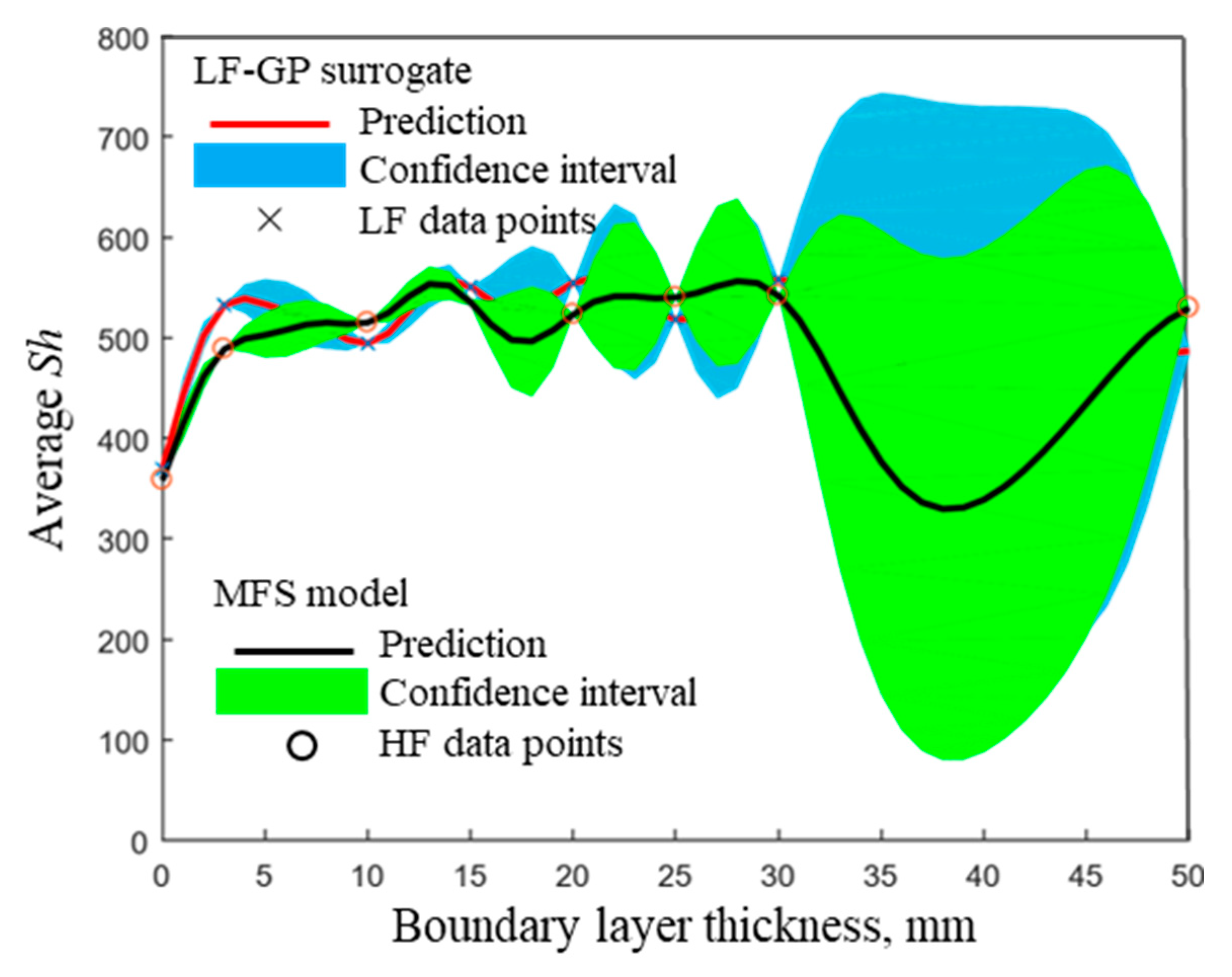

| Parameters | Values |
|---|---|
| Axial chord, mm | 114.62 |
| Inlet angle, deg | 46.23 |
| Leading-edge radius, mm | 17.07 |
| Pitch, mm | 80.0 |
| Tip clearance, mm | 6.0 |
| No of High-Fidelity Data | RMSE | Error Rate |
|---|---|---|
| 0 (low-fidelity surrogate) | 32.48 | 7.26 |
| 4 | 52.84 | 11.81 |
| 6 | 51.66 | 11.54 |
| 11 | 49.51 | 11.06 |
| 14 | 47.04 | 10.51 |
| 18 | 34.87 | 7.79 |
| 21 | 29.95 | 6.69 |
| 22 | 29.18 | 6.52 |
| High-fidelity surrogate | 29.95 | 6.69 |
Publisher’s Note: MDPI stays neutral with regard to jurisdictional claims in published maps and institutional affiliations. |
© 2021 by the authors. Licensee MDPI, Basel, Switzerland. This article is an open access article distributed under the terms and conditions of the Creative Commons Attribution (CC BY) license (http://creativecommons.org/licenses/by/4.0/).
Share and Cite
Choi, W.; Radhakrishnan, K.; Kim, N.-H.; Park, J.S. Multi-Fidelity Surrogate Models for Predicting Averaged Heat Transfer Coefficients on Endwall of Turbine Blades. Energies 2021, 14, 482. https://doi.org/10.3390/en14020482
Choi W, Radhakrishnan K, Kim N-H, Park JS. Multi-Fidelity Surrogate Models for Predicting Averaged Heat Transfer Coefficients on Endwall of Turbine Blades. Energies. 2021; 14(2):482. https://doi.org/10.3390/en14020482
Chicago/Turabian StyleChoi, Woosung, Kanmaniraja Radhakrishnan, Nam-Ho Kim, and Jun Su Park. 2021. "Multi-Fidelity Surrogate Models for Predicting Averaged Heat Transfer Coefficients on Endwall of Turbine Blades" Energies 14, no. 2: 482. https://doi.org/10.3390/en14020482






